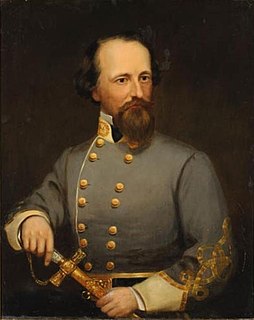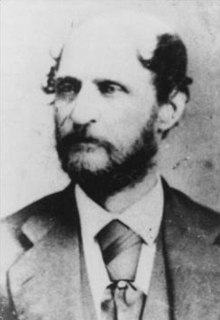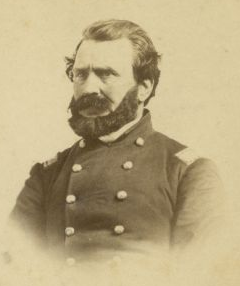
The Battle of Gettysburg was fought July 1–3, 1863, in and around the town of Gettysburg, Pennsylvania, by Union and Confederate forces during the American Civil War. In the battle, Union Major General George Meade's Army of the Potomac defeated attacks by Confederate General Robert E. Lee's Army of Northern Virginia, halting Lee's invasion of the North. The battle involved the largest number of casualties of the entire war and is often described as the war's turning point due to the Union's decisive victory and concurrence with the Siege of Vicksburg.

John Fulton Reynolds was a career United States Army officer and a general in the American Civil War. One of the Union Army's most respected senior commanders, he played a key role in committing the Army of the Potomac to the Battle of Gettysburg and was killed at the start of the battle.

James Johnston Pettigrew was an American author, lawyer, and soldier. He served in the army of the Confederate States of America, fighting in the 1862 Peninsula Campaign and played a prominent role in the Battle of Gettysburg. Despite starting the Gettysburg Campaign commanding a brigade, Pettigrew took over command of his division after the division's original commander Henry Heth was wounded. In this role, Pettigrew was one of three division commanders in the disastrous assault known as Pickett's Charge on the final day of Gettysburg. He was badly wounded during the assault and was later mortally wounded during a Union attack while the Confederates retreated to Virginia near Falling Waters, West Virginia, dying several days later.

Birkett Davenport Fry was an adventurer, soldier, lawyer, cotton manufacturer, and a Confederate brigadier general in the American Civil War. A survivor of four battle wounds, he commanded one of the lead brigades during Pickett's Charge at the Battle of Gettysburg.

The first day of the Battle of Gettysburg during the American Civil War took place on July 1, 1863, and began as an engagement between isolated units of the Army of Northern Virginia under Confederate General Robert E. Lee and the Army of the Potomac under Union Maj. Gen. George G. Meade. It soon escalated into a major battle which culminated in the outnumbered and defeated Union forces retreating to the high ground south of Gettysburg, Pennsylvania.
John Mansfield was an American lawyer, Republican politician, and Union Army officer in the American Civil War. He commanded the 2nd Wisconsin Infantry Regiment in the famous Iron Brigade and later served as the 15th lieutenant governor of California.

James Jay Archer was a lawyer and an officer in the United States Army during the Mexican–American War. He later served as a brigadier general in the Confederate States Army (CSA) during the American Civil War.

John Lawrence Burns was an American soldier and constable. A veteran of the War of 1812, at age 69 he fought as a civilian combatant with the Union Army at the Battle of Gettysburg during the American Civil War. He was wounded, but survived to become a national celebrity.
The 24th Michigan Infantry Regiment was an infantry regiment that served in the Union Army during the American Civil War. It was part of the Union Iron Brigade.
The 2nd Wisconsin Infantry Regiment was an infantry regiment that served in the Union Army during the American Civil War. It spent most of the war as a member of the famous Iron Brigade of the Army of the Potomac. It suffered the largest number of casualties as a percentage of its total enlistment of any Union Army unit in the war.
The 7th Wisconsin Infantry Regiment was an infantry regiment that served in the Union Army during the American Civil War. It was a component of the famous Iron Brigade in the Army of the Potomac throughout the war.

The 8th Illinois Cavalry Regiment was a cavalry regiment that served in the Union Army during the American Civil War. The regiment served the duration of the war, and was the only Illinois cavalry regiment to serve the entire war in the Army of the Potomac. They also aided in the hunt for John Wilkes Booth and served as President Lincoln's honor guard while he lay in state under the rotunda. Lincoln gave them the nickname of "Farnsworth's Abolitionist Regiment" when he watched them march past the White House.

The 14th Regiment New York State Militia was a volunteer militia regiment from the City of Brooklyn, New York. It is primarily known for its service in the American Civil War from April 1861 to 6 May 1864, although it later served in the Spanish–American War and World War I.

The Iron Brigade, also known as The Black Hats, Black Hat Brigade, Iron Brigade of the West, and originally King's Wisconsin Brigade was an infantry brigade in the Union Army of the Potomac during the American Civil War. Although it fought entirely in the Eastern Theater, it was composed of regiments from three Western states that are now within the region of the Midwest. Noted for its strong discipline, its unique uniform appearance and its tenacious fighting ability, the Iron Brigade suffered the highest percentage of casualties of any brigade in the war.

Chapman Biddle was a member of the prominent Biddle family of Philadelphia, Pennsylvania, who served as an officer in the Union Army in the American Civil War. He commanded a brigade of infantry at the Battle of Gettysburg.

The 151st Pennsylvania Infantry was a Union Army regiment serving for a term of nine months during the American Civil War. The regiment sustained seventy-six percent casualties in the Battle of Gettysburg, its only major engagement. Following the war, it became popularly known as "The Schoolteachers' Regiment" due to the presence of at least sixty teachers in the regiment's ranks.

The 14th Tennessee Infantry Regiment was a unit of the Confederate States Army during the American Civil War. It was one of the few western regiments that fought as part of the Army of Northern Virginia in the east; participating in most major battles conducted by Robert E. Lee.

William Wallace Robinson, Sr., was a Union Army officer and American diplomat. He commanded the 7th Wisconsin Infantry Regiment in the famed Iron Brigade of the Army of the Potomac through most of the Civil War, and was U.S. consul to the Merina Kingdom of Madagascar for 12 years (1875–1887).
The railway cut of the Gettysburg Battlefield was the place of an 1863 military engagement during the first Day of the Battle of Gettysburg, near the Edward McPherson farmhouse. It was an excavation in which railroad tracks had not yet been placed, but which provided a deep entrenchment. During the day, units from the Union Army of the Potomac deployed near the railway cut to contest the attacks of the Confederate Army of Northern Virginia. The Confederates were held off during the morning and early afternoon but were able to drive off the Union army due to superior numbers.

McPherson Ridge is a landform used for military engagements during the 1863 Battle of Gettysburg, when the I Corps of the Union Army had a headquarters on the ridge and was defeated by the Confederate division of Major General Henry Heth. The ridge has terrain above ~530 ft (160 m) and is almost entirely a federally protected area except for township portions at the southern end and along Pennsylvania Route 116, including a PennDOT facility. The northern end is a slight topographic saddle point on the west edge of Oak Ridge, and summit areas above 560 ft (170 m) include 4 on/near the Lincoln Highway, a broader summit south of the Fairfield Road, and the larger plateau at the northern saddle.















